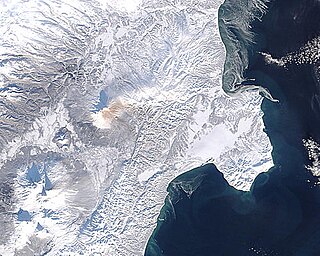Related Research Articles
CiteSeerX is a public search engine and digital library for scientific and academic papers, primarily in the fields of computer and information science.

The Goddard Space Flight Center (GSFC) is a major NASA space research laboratory located approximately 6.5 miles (10.5 km) northeast of Washington, D.C. in Greenbelt, Maryland, United States. Established on May 1, 1959 as NASA's first space flight center, GSFC employs about 10,000 civil servants and contractors. Named for American rocket propulsion pioneer Robert H. Goddard, it is one of ten major NASA field centers. GSFC is partially within the former Goddard census-designated place; it has a Greenbelt mailing address.

The Moderate Resolution Imaging Spectroradiometer (MODIS) is a satellite-based sensor used for earth and climate measurements. There are two MODIS sensors in Earth orbit: one on board the Terra satellite, launched by NASA in 1999; and one on board the Aqua satellite, launched in 2002. MODIS has now been replaced by the VIIRS, which first launched in 2011 aboard the Suomi NPP satellite.
The Earth Observing System (EOS) is a program of NASA comprising a series of artificial satellite missions and scientific instruments in Earth orbit designed for long-term global observations of the land surface, biosphere, atmosphere, and oceans. Since the early 1970s, NASA has been developing its Earth Observing System, launching a series of Landsat satellites in the decade. Some of the first included passive microwave imaging in 1972 through the Nimbus 5 satellite. Following the launch of various satellite missions, the conception of the program began in the late 1980s and expanded rapidly through the 1990s. Since the inception of the program, it has continued to develop, including; land, sea, radiation and atmosphere. Collected in a system known as EOSDIS, NASA uses this data in order to study the progression and changes in the biosphere of Earth. The main focus of this data collection surrounds climatic science. The program is the centrepiece of NASA's Earth Science Enterprise.

Hierarchical Data Format (HDF) is a set of file formats designed to store and organize large amounts of data. Originally developed at the U.S. National Center for Supercomputing Applications, it is supported by The HDF Group, a non-profit corporation whose mission is to ensure continued development of HDF5 technologies and the continued accessibility of data stored in HDF.
Sensor web is a type of sensor network that heavily utilizes the World Wide Web and is especially suited for environmental monitoring. OGC's Sensor Web Enablement (SWE) framework defines a suite of web service interfaces and communication protocols abstracting from the heterogeneity of sensor (network) communication.
The Earth System Modeling Framework (ESMF) is open-source software for building climate, numerical weather prediction, data assimilation, and other Earth science software applications. These applications are computationally demanding and usually run on supercomputers. The ESMF is considered a technical layer, integrated into a sophisticated common modeling infrastructure for interoperability. Other aspects of interoperability and shared infrastructure include: common experimental protocols, common analytic methods, common documentation standards for data and data provenance, shared workflow, and shared model components.

Fedora is a digital asset management (DAM) content repository architecture upon which institutional repositories, digital archives, and digital library systems might be built. Fedora is the underlying architecture for a digital repository, and is not a complete management, indexing, discovery, and delivery application. It is a modular architecture built on the principle that interoperability and extensibility are best achieved by the integration of data, interfaces, and mechanisms as clearly defined modules.
The Earth Observing System Data and Information System (EOSDIS) is a key core capability in NASA’s Earth Science Data Systems Program. Designed and maintained by Raytheon Intelligence & Space, it is a comprehensive data and information system designed to perform a wide variety of functions in support of a heterogeneous national and international user community.
Geospatial metadata is a type of metadata applicable to geographic data and information. Such objects may be stored in a geographic information system (GIS) or may simply be documents, data-sets, images or other objects, services, or related items that exist in some other native environment but whose features may be appropriate to describe in a (geographic) metadata catalog.
The Global Change Master Directory holds more than 28,000 data set descriptions, known as DIFs. This format is compatible with the Federal Geographic Data Committee's (FGDC) standard and the international ISO 19115 standard. The purpose of the directory is to provide users with information on the availability of data and services that will meet their needs, along with efficient access to those data and services. Links are provided, when available, to connect directly to the data or services of interest.

Metadata is "data that provides information about other data", but not the content of the data itself, such as the text of a message or the image itself. There are many distinct types of metadata, including:

Earth Science Information Partners (ESIP) is a community of data and information technology practitioners that come together to coordinate Earth science interoperability efforts. Participation in ESIP allows members to enhance their data management capabilities.
AGRIS is a global public domain database with more than 12 million structured bibliographical records on agricultural science and technology. It became operational in 1975 and the database was maintained by Coherence in Information for Agricultural Research for Development, and its content is provided by more than 150 participating institutions from 65 countries. The AGRIS Search system, allows scientists, researchers and students to perform sophisticated searches using keywords from the AGROVOC thesaurus, specific journal titles or names of countries, institutions, and authors.
The ORNL DAAC for Biogeochemical Dynamics is a National Aeronautics and Space Administration (NASA) Earth Observing System Data and Information System (EOSDIS) data center managed by the Earth Science Data and Information System (ESDIS) Project. Established in 1993, the ORNL DAAC is operated by Oak Ridge National Laboratory in Oak Ridge, Tennessee, under an interagency agreement between NASA and the Department of Energy (DOE). Within the ORNL, the ORNL DAAC is part of the Remote Sensing and Environmental Informatics Group of the Environmental Sciences Division (ESD) and a contributor to the Climate Change Science Institute (CCSI).
GEOMS – Generic Earth Observation Metadata Standard is a metadata standard used for archiving data from groundbased networks, like the Network for the Detection of Atmospheric Composition Change (NDACC), and for using this kind of data for the validation of NASA and ESA satellite data.
The Alaska Satellite Facility is a data processing facility and satellite-tracking ground station within the Geophysical Institute at the University of Alaska Fairbanks. The facility’s mission is to make remote-sensing data accessible Its work is central to polar processes research including wetlands, glaciers, sea ice, climate change, permafrost, flooding and land cover such as changes in the Amazon rainforest.
MyCoRe is an open source repository software framework for building disciplinary or institutional repositories, digital archives, digital libraries, and scientific journals. The software is developed at various German university libraries and computer centers. Although most MyCoRe web applications are located in Germany, there are English-language applications, such as "The International Treasury of Islamic Manuscripts" at the University of Cambridge (UK).

Eni G. Njoku is a Nigerian-American scientist specializing in microwave remote sensing. He worked at the Jet Propulsion Laboratory (JPL), California Institute of Technology, where he was responsible for developing techniques for sea surface temperature and soil moisture remote sensing using microwave radiometers. He produced the first microwave-derived sea surface temperature maps from space, and developed the first application of deployable mesh antennas for satellite Earth observation. From 2008-2013, he served as project scientist of NASA's first soil moisture mission, the Soil Moisture Active Passive (SMAP) mission, launched in 2015.

The SeaWiFS Bio-optical Archive and Storage System (SeaBASS) is a data archive of in situ oceanographic data used to support satellite remote sensing research of ocean color. SeaBASS is used for developing algorithms for satellite-derived variables and for validating or “ground-truthing” satellite-derived data products. The acronym begins with “S” for SeaWiFS, because the data repository began in the 1990s around the time of the launch of the SeaWiFS satellite sensor, and the same data archive has been used ever since. Oceanography projects funded by the NASA Earth Science program are required to upload data collected on research campaigns to the SeaBASS data repository to increase the volume of open-access data available to the public. As of 2021 the data archive contained information from thousands of field campaigns uploaded by over 100 principal investigators.
References
- ↑ M. Esfandiari, H. Ramapriyan, J. Behnke and E. Sofinowski, "Earth observing system (EOS) data and information system (EOSDIS) — evolution update and future," 2007 IEEE International Geoscience and Remote Sensing Symposium, Barcelona, Spain, 2007, pp. 4005-4008, doi: 10.1109/IGARSS.2007.4423727. keywords: {Earth Observing System;Information systems;Data systems;Geoscience;Instruments;NASA;Information technology;Data processing;Collaboration;Usability},
- ↑ Bugbee, Kaylin; Roux, Jeanné le; Sisco, Adam; Kaulfus, Aaron; Staton, Patrick; Woods, Camille; Dixon, Valerie; Lynnes, Christopher; Ramachandran, Rahul (2021-04-28). "Improving Discovery and Use of NASA's Earth Observation Data Through Metadata Quality Assessments". Data Science Journal. 20 (1). doi: 10.5334/dsj-2021-017 . ISSN 1683-1470.
- ↑ Earth Science Data Systems, NASA (2019-06-05). "Common Metadata Repository (CMR) | Earthdata". www.earthdata.nasa.gov. Retrieved 2024-02-03.